Richard and Diane Van Vleck Personal Pages
The Home Habitat |
2005 Nest Box Cam
Northern Flicker
Colaptes auratus
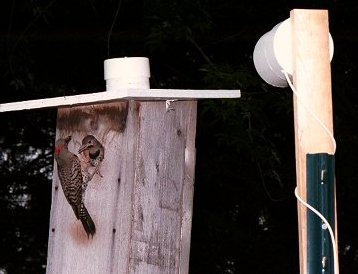 Two pairs of yellow shafted flickers nested simultaneously in our yard this year. The pair in the barnyard box fledged 4 young from a clutch of 9 eggs. The nesting in the sycamore tree failed due to the loss of the male a day before the young hatched. But, neither of these nestings was affected by starlings. Several factors may have contributed to this year's success in fending off starlings. On the part of the flickers, it seems that this year's successful pair have learned to never get trapped inside the nesting cavity with a starling. On the human's part, I have provided alternative nest boxes for starlings near the flicker box and kept them empty by promptly trapping or shooting starlings as they claimed these decoy boxes. Also, continual use of the automatic repeating traps on the barn walls have reduced the number of starling pairs searching for a nest site at any one time.
Two pairs of yellow shafted flickers nested simultaneously in our yard this year. The pair in the barnyard box fledged 4 young from a clutch of 9 eggs. The nesting in the sycamore tree failed due to the loss of the male a day before the young hatched. But, neither of these nestings was affected by starlings. Several factors may have contributed to this year's success in fending off starlings. On the part of the flickers, it seems that this year's successful pair have learned to never get trapped inside the nesting cavity with a starling. On the human's part, I have provided alternative nest boxes for starlings near the flicker box and kept them empty by promptly trapping or shooting starlings as they claimed these decoy boxes. Also, continual use of the automatic repeating traps on the barn walls have reduced the number of starling pairs searching for a nest site at any one time.
Early spring - The typical starling domination
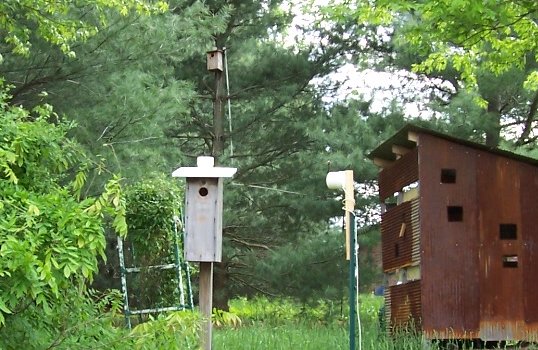 By late March, a male flicker was visiting nest sites, including the sycamore cavity and a new flicker box near the martin gourd rack. He also spent several hours each day drumming on the metal elevator of an old combine. It was several weeks before he finally attracted, not one, but two females. The threesome traveled around the property for over a week, with the females perching close together and posturing in a most comic fashion, throwing back their heads and swaying about. Although they were often only 2 or 3 inches apart, I never saw them make contact. This was a very civil rivalry. Finally one of them seemed to win the male and they settled on the new box by the martin gourd rack. They were soon driven off by a pair of starlings who claimed that box. I trapped one starling and shot the other, once again freeing up the box for the flickers. They were soon observed entering the box, but, were again driven off by another pair of starlings. I was slow in shooting this second starling pair, but, the flickers, in the meantime, had moved on to the nest box in the barn yard, which they seemed intent on protecting from starlings. They were taking turns perching in the entrance hole, never leaving the box unguarded.
By late March, a male flicker was visiting nest sites, including the sycamore cavity and a new flicker box near the martin gourd rack. He also spent several hours each day drumming on the metal elevator of an old combine. It was several weeks before he finally attracted, not one, but two females. The threesome traveled around the property for over a week, with the females perching close together and posturing in a most comic fashion, throwing back their heads and swaying about. Although they were often only 2 or 3 inches apart, I never saw them make contact. This was a very civil rivalry. Finally one of them seemed to win the male and they settled on the new box by the martin gourd rack. They were soon driven off by a pair of starlings who claimed that box. I trapped one starling and shot the other, once again freeing up the box for the flickers. They were soon observed entering the box, but, were again driven off by another pair of starlings. I was slow in shooting this second starling pair, but, the flickers, in the meantime, had moved on to the nest box in the barn yard, which they seemed intent on protecting from starlings. They were taking turns perching in the entrance hole, never leaving the box unguarded.
There were two large flycatcher boxes and a screech owl box in trees near the flicker box, all empty and serving as decoy starling boxes. It seems that if a nest box of equal value is available near a flicker nest box, a starling pair will choose the unclaimed box, rather than fight the flickers. This is only my belief, based on limited observations. However, as soon as the decoy box is claimed by a starling pair, the next pair to arrive, looking for a nest site, will do battle with the flickers rather than risk fighting their own kind. This means starlings must be promptly removed from the decoy boxes and the overall starling pressure must be kept as low as possible by the use of automatic repeating traps placed in high interest areas. In our case, this is limited to the walls of buildings - 4 traps on our barn and one each on the house and chicken coop. Far more starlings are caught in these traps than are inspecting the flicker and decoy boxes.
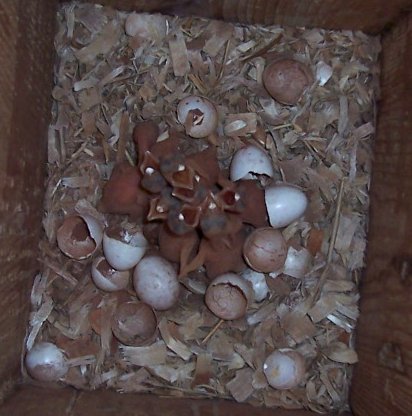
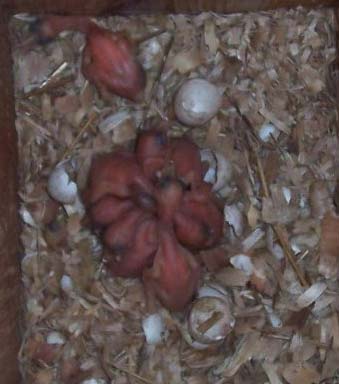
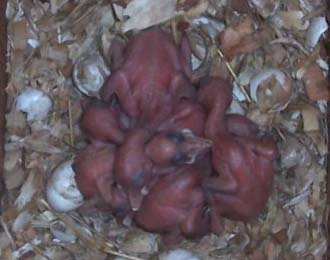
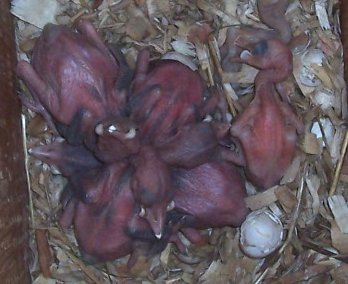
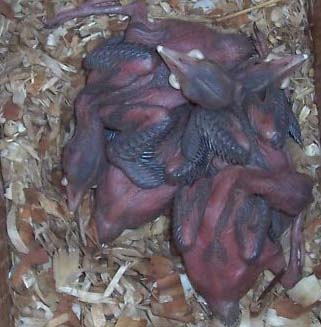
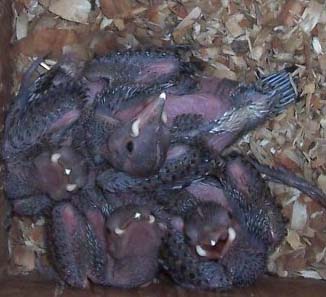
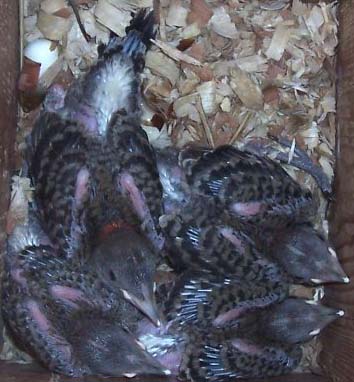
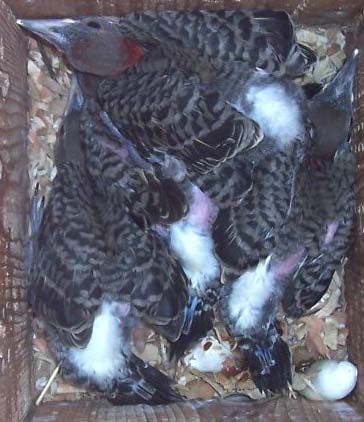
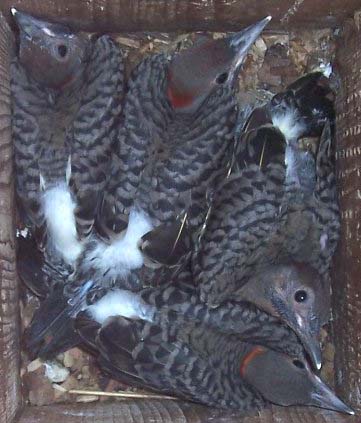
The following still photos are taken from a single frame of video from the vhs tapes. This process results in a substantial loss of quality compared to the original camera image and vhs tape. The upper left quadrant is inside the flicker box. The upper right is outside the box, recording all visits to the entrance hole as well as the roof. The lower left is a bat cam, useful only at night, and the lower right is the weather cam.
5/15/2005 flicker taking an incubation break and peering out the entrance hole.
5/19/2005 confrontation with a gray squirrel The female virtually exploded from the box when she heard the squirrel. She jumped on top of the box before even seeing the squirrel on the side. The next instant, both male and female flickers attacked the squirrel, which immediately jumped out of camera view and never returned during the remainder of the nesting. A similar incident happened 2 days before with a starling. Both the male and female instantly attacked the starling outside the box. A starling returned several minutes later, and was, again, immediately attacked by both adults, the male from above and the female exploding from the box. No other starlings visited the box during the remainder of the nesting.
5/19/2005 female arrives to relieve the male
Daily activity log derived from continuous videotape
Summary of activity on 3 sampling days (small pdf file)
5/15/2005 incubation
The Sycamore Nest Cam
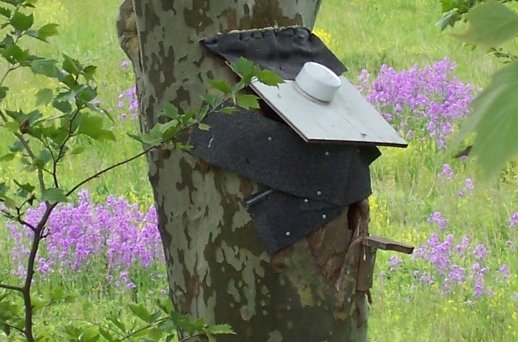 A second pair of flickers claimed the cavity in the front yard sycamore tree that had been excavated by flickers in 2001. A lid with camera adapter and a perch had been added when the trunk above the cavity fell off in 2002. Several starlings had been shot on the perch this spring and a clutch of eggs removed. While several starlings were actively nesting in the sycamores at this time and many were being caught in the barn traps, none bothered this 2nd flicker pair as they incubated 6 eggs. However, 1 or 2 days before hatching, the male disappeared, likely eaten by something. Flickers spend a great deal of time on the ground, dining on ants, where they are at greater risk of predation.
A second pair of flickers claimed the cavity in the front yard sycamore tree that had been excavated by flickers in 2001. A lid with camera adapter and a perch had been added when the trunk above the cavity fell off in 2002. Several starlings had been shot on the perch this spring and a clutch of eggs removed. While several starlings were actively nesting in the sycamores at this time and many were being caught in the barn traps, none bothered this 2nd flicker pair as they incubated 6 eggs. However, 1 or 2 days before hatching, the male disappeared, likely eaten by something. Flickers spend a great deal of time on the ground, dining on ants, where they are at greater risk of predation.
The widowed flicker offered a great opportunity for learning how much a female can compensate for the loss of her mate in caring for the young. A nest cam was in place the day of hatching and continuous video revealed that she did little different than if her mate had been present. She left the nest in the evening, to roost elsewhere, just as she would have if the male had been present to brood overnight. She returned at the usual time the following morning and made more frequent visits to the nest to brood the newly hatched young. The second night, she again left the nest to roost elsewhere. The following day, she made several visits to the nest to feed and brood the young and then deserted the nest. Several of the young were still alive and appeared to be responding normally to her feeding visits. What factors determined that it was time to desert were unclear.
female brooding in the sycamore cavity (from the videotape)
American Artifacts home
email richard@americanartifacts.com
© 2005, 2013, American Artifacts and Richard Van Vleck, Taneytown, Maryland.
 Two pairs of yellow shafted flickers nested simultaneously in our yard this year. The pair in the barnyard box fledged 4 young from a clutch of 9 eggs. The nesting in the sycamore tree failed due to the loss of the male a day before the young hatched. But, neither of these nestings was affected by starlings. Several factors may have contributed to this year's success in fending off starlings. On the part of the flickers, it seems that this year's successful pair have learned to never get trapped inside the nesting cavity with a starling. On the human's part, I have provided alternative nest boxes for starlings near the flicker box and kept them empty by promptly trapping or shooting starlings as they claimed these decoy boxes. Also, continual use of the automatic repeating traps on the barn walls have reduced the number of starling pairs searching for a nest site at any one time.
Two pairs of yellow shafted flickers nested simultaneously in our yard this year. The pair in the barnyard box fledged 4 young from a clutch of 9 eggs. The nesting in the sycamore tree failed due to the loss of the male a day before the young hatched. But, neither of these nestings was affected by starlings. Several factors may have contributed to this year's success in fending off starlings. On the part of the flickers, it seems that this year's successful pair have learned to never get trapped inside the nesting cavity with a starling. On the human's part, I have provided alternative nest boxes for starlings near the flicker box and kept them empty by promptly trapping or shooting starlings as they claimed these decoy boxes. Also, continual use of the automatic repeating traps on the barn walls have reduced the number of starling pairs searching for a nest site at any one time.
 By late March, a male flicker was visiting nest sites, including the sycamore cavity and a new flicker box near the martin gourd rack. He also spent several hours each day drumming on the metal elevator of an old combine. It was several weeks before he finally attracted, not one, but two females. The threesome traveled around the property for over a week, with the females perching close together and posturing in a most comic fashion, throwing back their heads and swaying about. Although they were often only 2 or 3 inches apart, I never saw them make contact. This was a very civil rivalry. Finally one of them seemed to win the male and they settled on the new box by the martin gourd rack. They were soon driven off by a pair of starlings who claimed that box. I trapped one starling and shot the other, once again freeing up the box for the flickers. They were soon observed entering the box, but, were again driven off by another pair of starlings. I was slow in shooting this second starling pair, but, the flickers, in the meantime, had moved on to the nest box in the barn yard, which they seemed intent on protecting from starlings. They were taking turns perching in the entrance hole, never leaving the box unguarded.
By late March, a male flicker was visiting nest sites, including the sycamore cavity and a new flicker box near the martin gourd rack. He also spent several hours each day drumming on the metal elevator of an old combine. It was several weeks before he finally attracted, not one, but two females. The threesome traveled around the property for over a week, with the females perching close together and posturing in a most comic fashion, throwing back their heads and swaying about. Although they were often only 2 or 3 inches apart, I never saw them make contact. This was a very civil rivalry. Finally one of them seemed to win the male and they settled on the new box by the martin gourd rack. They were soon driven off by a pair of starlings who claimed that box. I trapped one starling and shot the other, once again freeing up the box for the flickers. They were soon observed entering the box, but, were again driven off by another pair of starlings. I was slow in shooting this second starling pair, but, the flickers, in the meantime, had moved on to the nest box in the barn yard, which they seemed intent on protecting from starlings. They were taking turns perching in the entrance hole, never leaving the box unguarded.









 A second pair of flickers claimed the cavity in the front yard sycamore tree that had been excavated by flickers in 2001. A lid with camera adapter and a perch had been added when the trunk above the cavity fell off in 2002. Several starlings had been shot on the perch this spring and a clutch of eggs removed. While several starlings were actively nesting in the sycamores at this time and many were being caught in the barn traps, none bothered this 2nd flicker pair as they incubated 6 eggs. However, 1 or 2 days before hatching, the male disappeared, likely eaten by something. Flickers spend a great deal of time on the ground, dining on ants, where they are at greater risk of predation.
A second pair of flickers claimed the cavity in the front yard sycamore tree that had been excavated by flickers in 2001. A lid with camera adapter and a perch had been added when the trunk above the cavity fell off in 2002. Several starlings had been shot on the perch this spring and a clutch of eggs removed. While several starlings were actively nesting in the sycamores at this time and many were being caught in the barn traps, none bothered this 2nd flicker pair as they incubated 6 eggs. However, 1 or 2 days before hatching, the male disappeared, likely eaten by something. Flickers spend a great deal of time on the ground, dining on ants, where they are at greater risk of predation.